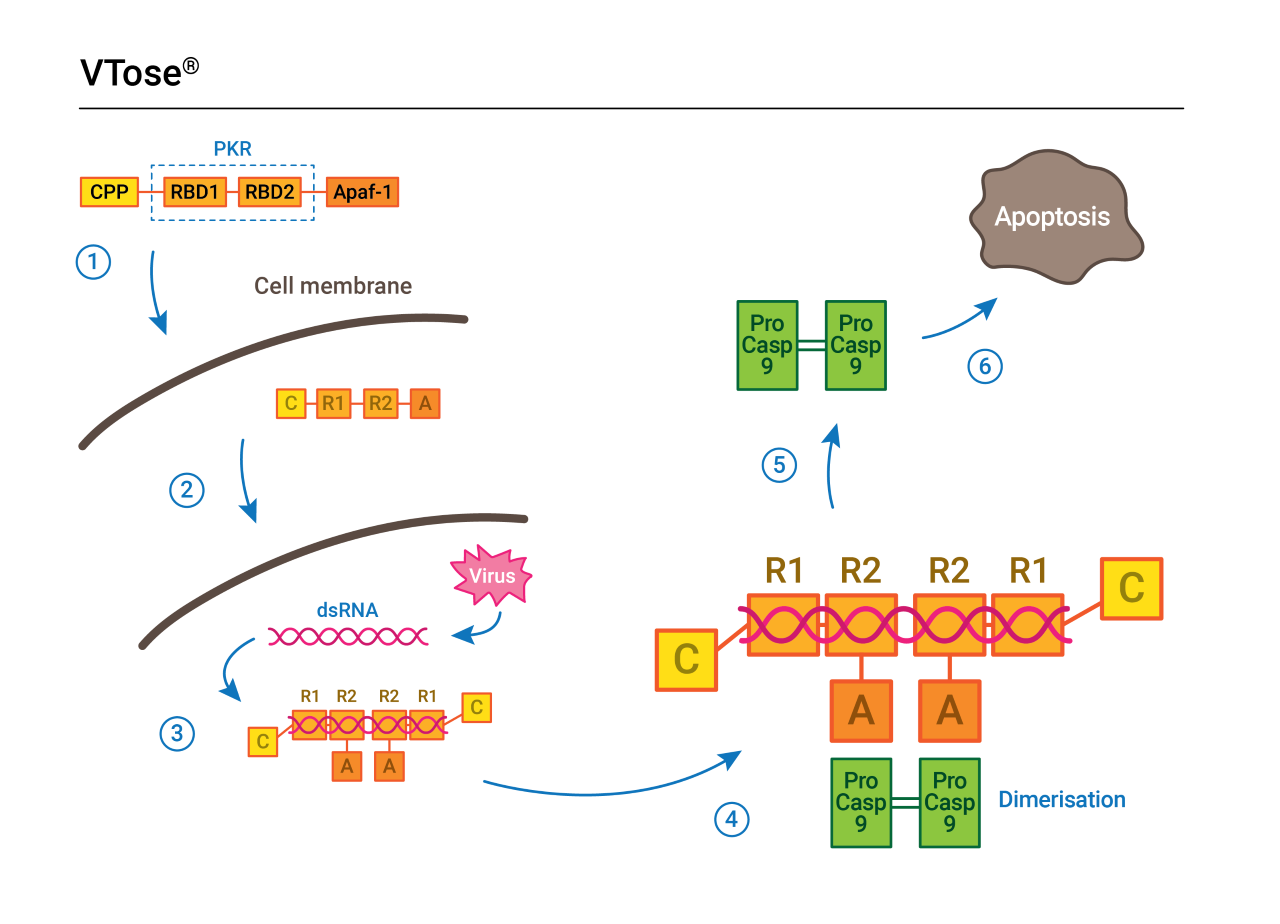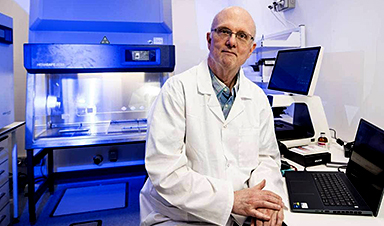By taking aim at a process common across many viruses, the drug could one day stop any number of known viruses — and new ones.
t’s about as audacious an idea as you can find in the world of infectious disease: a broad-spectrum antiviral — a “penicillin for viruses.”
The stakes are incredibly high. The yearly tide of seasonal flu causes three to five million severe cases annually, killing hundreds of thousands of people. The “break-bone fever” of dengue virus threatens roughly half the world’s population. 350 million people today are living with hepatitis B or C, leading to millions of cases of liver disease and cancer. The HIV and COVID-19 pandemics have already killed tens of millions, and viruses from Ebola to bird flu are constantly threatening future epidemics, too.
All told, viral infections will account for tens of millions of deaths and trillions in economic losses over the coming decades. A drug that could treat all of them — or even a broad class of them — would be huge.
Viral infections will account for tens of millions of deaths and trillions in economic losses over the coming decades. A drug that could treat all of them — or even a broad class of them — would be huge.
Viruses have sophisticated defenses, developed over eons of evolution. When they are inside cells, it’s generally too late. When they’re outside of cells, these tiny invaders are difficult to spot. And one favorite drug technique — attacking the biochemical pathways of organisms — does not work on viruses; they aren’t even alive.
“So yeah, it’s a hard problem.”
The New Zealand-based startup Kimer Med, where Kiessig is the co-founder, chief science officer, and CEO, is taking on the ambitious mission of solving that problem. Inspired by work published in 2011, they are trying to develop a broad-spectrum antiviral that uses a target in human cells to hopefully attack a wide variety of viruses.
An inspiration
The previous approach, called DRACO, and Kimer’s new candidate, called VTose (pronounced “vee-tohs”), both hinge on something called double-stranded RNA. But while their targets are the same, VTose uses different proteins to form its virus-fighting “toolkit,” as Kiessig puts it.
Double-stranded RNA, or dsRNA, is a signature of virus replication in cells, a signal that most viral infections create.
The new design, VTose, recognizes the dsRNA and triggers a process called apoptosis, programmed death, in the infected cell — hopefully stopping the infection in its tracks.
Apoptosis is “a well understood process,” Mark Hickman, a senior scientist with a component of the US Department of Defense’s Chemical and Biological Defense Program, tells Freethink. Hickman and colleagues helped develop relatively broad-spectrum antivirals against filoviruses, like Ebola and Marbrug, which culminated in the drug remdesivir (which was later repurposed to fight COVID-19).
Taking aim at dsRNA to make a broad-spectrum antiviral “sounds plausible,” Hickman says, with the caveat that more data, including clinical data, is needed.
The dsRNA mechanism has already shown some promise. In 2011, Todd Rider — a polymath with multiple degrees from MIT, then affiliated with MIT’s Lincoln Laboratory — and colleagues published the initial DRACO paper as proof-of-concept.
In those initial studies, the Rider Institute explains, DRACO was found to be effective against 18 different viruses in 13 different kinds of mammalian cells, including type 2 dengue virus, H1N1 influenza, and multiple rhinoviruses and coronaviruses, which cause the common cold. It was also found to be nontoxic in mice and protected or rescued them from a number of virus challenges, including H1N1 influenza.
In August 2021, a year after its founding, Kimer Med licensed the final DRACO-related patent from MIT and started building their own broad-spectrum antiviral.
The new contender
Kimer’s drug is unlike most antivirals, which use small molecules. Instead, VTose is a large, complex molecule, built from pieces of proteins that are present in most of our cells.
Large and small compounds have different advantages and drawbacks. While they can cost more to develop, Kiessig says, small molecule antivirals are cheaper and easier to make than large molecules. But their antiviral abilities can cut both ways. Small molecule compounds have a history of being “relatively toxic” to healthy cells, Kiessig says — hence the expensive initial development.
“It requires a lot of work, a lot of different trials — hundreds of different compounds, potentially — to try to find a nontoxic small molecule that both interferes with the pathway you want it to interfere with,” Kiessig says, “and doesn’t kill the patient in the process.”
Large molecule compounds have a better safety reputation, but are more difficult and expensive to manufacture.
The new design, VTose, recognizes dsRNA and triggers a process called apoptosis, programmed death, in the infected cell — hopefully stopping the infection in its tracks.
Targeting the host
Broad-spectrum antivirals fall into two different categories: antivirals that target the viruses directly, and antivirals that target the cells viruses infect and use for replication. Viruses are incredibly diverse, so finding a drug that directly works against a wide range of them would be a very difficult task.
Because it is host-directed, it should be more difficult for viruses to evolve their way around it — the bane of all antiviral treatments, from COVID-19 to HIV.
“We believe [how VTose works] is much more resistant to adaptation by the virus,” Kiessig says. “Because what we’re doing is actually attacking something that’s common across pretty much all viruses … we’re attacking a basic aspect of viral replication.”
A broad-spectrum HDA has another possible benefit: it could be developed before a new virus emerges.
“A pre-existing repertoire of first-line, broad-acting HDAs that can be readily deployed may be beneficial in slowing the initial viral spread or in suppressing outbreaks,” Boston University researcher Vipul C. Chitalia and drug discoverer Ali H. Munawar wrote in the Journal of Translational Medicine. “Later, HDAs can be complemented with [direct-acting antivirals] and vaccines since their development hinges on the knowledge of specific viral proteins.”
But to do that, a broad-spectrum antiviral needs a target that is common across many kinds of viruses — across viruses that infect different kinds of cells, in different ways — and is unlikely for the virus to mutate around. Enter double-stranded RNA.
“It is exactly the same sort of thing that the innate immune system tries to do.”
RICK KIESSIG
How VTose works
VTose works by taking aim at dsRNA.
According to researchers Y. Grace Chen and Sun Hur, at Yale and Harvard respectively, dsRNA is present in the majority of viral infections. It can come from the viral genome itself, or it can be created inside of cells during viral replication.
“Hence, nearly all organisms have the capability of recognizing dsRNA and mounting a response, the primary aim of which is to mitigate the potential infection,” they wrote.
Unfortunately, viruses are good at what they do and can flummox the efforts of the innate immune system, the first line of defense in cells that recognizes dsRNA.
VTose works by recognizing the long strings of dsRNA that occur when a virus tries to replicate inside a cell. The large molecule then triggers the infected cell’s natural suicide sequence — apoptosis — to protect the rest of the body.
“It is exactly the same sort of thing that the innate immune system tries to do,” Kiessig says.
The first part of VTose’s process uses the same protein that cells naturally use to detect viruses, a piece of an enzyme called PKR. When it detects an infection, VTose then uses part of a protein called Apaf-1, which kicks off a biochemical chain reaction that results in apoptosis, killing the cell before the virus can use it to replicate and spread the infection.
“You put those two things [together], and the idea is that now we have a protein that detects dsRNA … and it kills the cell,” Kiessig says.
Thus far, VTose has shown success against dengue and “a handful of other viruses” in cells — a first step on a long, treacherous path to clinical trials and, if it works there, hospitals.

The Challenges
Multiple hurdles stand in the way of that, not the least of which is whether this drug even works at stopping viruses in humans at all — rather than Petri dishes or mice.
“The majority of phase 1 drugs and therapeutics die in phase 1,” Hickman, the DoD senior scientist, says.
There’s good animal models for infectious disease — mice and monkeys get infected by viruses in a very similar way to humans — but many drugs die because they are simply, and unexpectedly, too toxic. Proving that a broad-spectrum antiviral is not toxic at the doses it needs to work will be one hurdle to cross.
While large molecules tend to be less toxic, they are more difficult and expensive to manufacture, and they face another barrier: the regulatory pathway for small molecule antivirals is better established. That means it’s clearer what you need to do to convince the FDA the drug is safe and effective — what experiments and data you need to collect, how the trials need to be designed and run, and so on.
“They understand it really well, and how it’s meant to work from end to end,” Kiessig says. There are approved large molecule drugs, but the paths are not as well trod — and that’s a problem for a small startup.
Of course, everything hinges on a question that can only be answered by reaching the stage DRACO never did: does it work in humans?
It’s a radical, ambitious idea — the kind that naturally draws healthy, warranted skepticism. But if it does, VTose could be a powerful new weapon for public health. Kiessig is excited by the prospect.
“The opportunity here is tremendous,” Kiessig says. “If we’re successful, we have an opportunity to make a change that’s as significant as broad-spectrum antibiotics were for the world.”
News
Global Nanomaterial Regulation: A Country-by-Country Comparison
Nanomaterials are materials with at least one dimension smaller than 100 nanometres (about 100,000 times thinner than a human hair). Because of their tiny size, they have unique properties that can be useful in [...]
Pandemic Potential: Scientists Discover 3 Hotspots of Deadly Emerging Disease in the US
Virginia Tech researchers discovered six new rodent carriers of hantavirus and identified U.S. hotspots, highlighting the virus’s adaptability and the impact of climate and ecology on its spread. Hantavirus recently drew public attention following reports [...]
Studies detail high rates of long COVID among healthcare, dental workers
Researchers have estimated approximately 8% of Americas have ever experienced long COVID, or lasting symptoms, following an acute COVID-19 infection. Now two recent international studies suggest that the percentage is much higher among healthcare workers [...]
Melting Arctic Ice May Unleash Ancient Deadly Diseases, Scientists Warn
Melting Arctic ice increases human and animal interactions, raising the risk of infectious disease spread. Researchers urge early intervention and surveillance. Climate change is opening new pathways for the spread of infectious diseases such [...]
Scientists May Have Found a Secret Weapon To Stop Pancreatic Cancer Before It Starts
Researchers at Cold Spring Harbor Laboratory have found that blocking the FGFR2 and EGFR genes can stop early-stage pancreatic cancer from progressing, offering a promising path toward prevention. Pancreatic cancer is expected to become [...]
Breakthrough Drug Restores Vision: Researchers Successfully Reverse Retinal Damage
Blocking the PROX1 protein allowed KAIST researchers to regenerate damaged retinas and restore vision in mice. Vision is one of the most important human senses, yet more than 300 million people around the world are at [...]
Differentiating cancerous and healthy cells through motion analysis
Researchers from Tokyo Metropolitan University have found that the motion of unlabeled cells can be used to tell whether they are cancerous or healthy. They observed malignant fibrosarcoma [...]
This Tiny Cellular Gate Could Be the Key to Curing Cancer – And Regrowing Hair
After more than five decades of mystery, scientists have finally unveiled the detailed structure and function of a long-theorized molecular machine in our mitochondria — the mitochondrial pyruvate carrier. This microscopic gatekeeper controls how [...]
Unlocking Vision’s Secrets: Researchers Reveal 3D Structure of Key Eye Protein
Researchers have uncovered the 3D structure of RBP3, a key protein in vision, revealing how it transports retinoids and fatty acids and how its dysfunction may lead to retinal diseases. Proteins play a critical [...]
5 Key Facts About Nanoplastics and How They Affect the Human Body
Nanoplastics are typically defined as plastic particles smaller than 1000 nanometers. These particles are increasingly being detected in human tissues: they can bypass biological barriers, accumulate in organs, and may influence health in ways [...]
Measles Is Back: Doctors Warn of Dangerous Surge Across the U.S.
Parents are encouraged to contact their pediatrician if their child has been exposed to measles or is showing symptoms. Pediatric infectious disease experts are emphasizing the critical importance of measles vaccination, as the highly [...]
AI at the Speed of Light: How Silicon Photonics Are Reinventing Hardware
A cutting-edge AI acceleration platform powered by light rather than electricity could revolutionize how AI is trained and deployed. Using photonic integrated circuits made from advanced III-V semiconductors, researchers have developed a system that vastly [...]
A Grain of Brain, 523 Million Synapses, Most Complicated Neuroscience Experiment Ever Attempted
A team of over 150 scientists has achieved what once seemed impossible: a complete wiring and activity map of a tiny section of a mammalian brain. This feat, part of the MICrONS Project, rivals [...]
The Secret “Radar” Bacteria Use To Outsmart Their Enemies
A chemical radar allows bacteria to sense and eliminate predators. Investigating how microorganisms communicate deepens our understanding of the complex ecological interactions that shape our environment is an area of key focus for the [...]
Psychologists explore ethical issues associated with human-AI relationships
It's becoming increasingly commonplace for people to develop intimate, long-term relationships with artificial intelligence (AI) technologies. At their extreme, people have "married" their AI companions in non-legally binding ceremonies, and at least two people [...]
When You Lose Weight, Where Does It Actually Go?
Most health professionals lack a clear understanding of how body fat is lost, often subscribing to misconceptions like fat converting to energy or muscle. The truth is, fat is actually broken down into carbon [...]





















